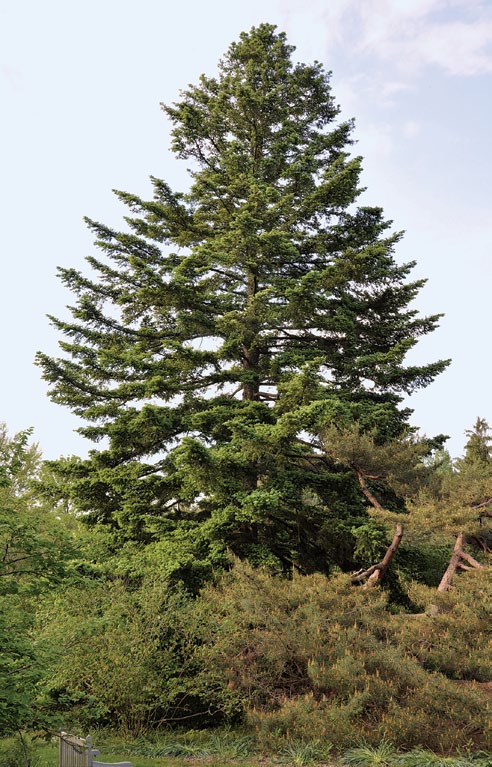Firs are among the most beautiful of landscape conifers. However, since firs are mainly native to cool northern areas or high elevations, many of them do not grow well south of New York City or in regions where summers can be very hot. The Manchurian fir, Abies holophylla, is among the most heat tolerant firs and has proven itself well adapted to midwest and mid-Atlantic states. It is also one of the most handsome firs, with distinctive bright green foliage color and a wide-spreading horizontal branching pattern with age (it is more pyramidal in youth). In addition to its heat tolerance, it is exceptionally winter hardy, capable of withstanding temperatures to -30°F (-34°C).
In nature, the Manchurian fir grows not only in the mountains but also at lower elevations and in valleys where it is exposed to hot summer temperatures. Its range includes North and South Korea, northeastern China, and far southeastern Russia. It often grows in association with Korean pine (Pinus koraiensis), Mongolian oak (Quercus mongolica), purplebloom (or Korean) maple (Acer pseudosieboldianum), and three-flowered maple (A. triflorum). It is among the tallest trees in the forest canopy, often exceeding 100 feet (30.5 meters). In China its wood is valued for use in construction and furniture, though it is not considered as high quality as the wood of Pinus koraiensis.


In the northeastern United States, with the decline of eastern hemlock (Tsuga canadensis) and the overuse of white pine (Pinus strobus) and Norway spruce (Picea abies), we have a need for a greater diversity of attractive, welladapted conifers. Since it was first introduced in 1905, Manchurian fir has proven itself to be a useful, non-invasive, and adaptable landscape plant. But unfortunately it is still little known outside of arboreta and botanic gardens. Until recently the germplasm represented in this country was narrow, not fully representing the species’ geographic range in its natural habitats. Through the work of collaborative expeditions to Korea in the 1980s by institutions that later formed NACPEC, followed by the 1993 and 1997 NACPEC expeditions to Hielongjiang and Jilin Provinces, the genetic representation in North America has been expanded.
Seedlings grown from accessions collected in Korea in 1981 are thriving and are now over 25 feet (7.6 meters) tall and 22 feet (6.7 meters) across at the ground. Seedlings from other accessions collected in China in 1993 are just hitting their stride, now standing 4 feet (1.2 meters) tall. At the Morris Arboretum, seeds were treated with cold stratification for 60 days at 41°F (5°C) before sowing. The seeds then generally germinated reliably within a few weeks. We have found that the seedlings are very slow growing for the first few years, but as they get established can grow over 18 inches (45.7 centimeters) a year.
Captions: Meyer, P. W. 2010. Manchurian fir: Abies holophylla. Arnoldia, 68(2): 55–57.
Several specimens of Abies holophylla have been growing well at the Morris Arboretum since before 1933. These mature specimens are over 70 feet (21.3 meters) tall and have taken on a distinctive broadspreading horizontal habit. A prized specimen at the Morton Arboretum in Lisle, Illinois, was planted in 1939 and is considered one of their best firs. Curator Kunso Kim reports young plants from the NACPEC expeditions are also performing well at the Morton Arboretum. He observes that the Manchurian fir is relatively shade tolerant, although plants have a more open habit in the shade. Heavy clay or poorly drained soils can be problematic for firs, so planting on higher, well-drained sites is recommended.
Landscape-sized Manchurian firs are difficult to find in nurseries, but small plants are sometimes listed by specialty mail order nurseries. A diligent and patient collector will certainly be rewarded with a fine growing specimen.
Paul W. Meyer is the F. Otto Haas Director of the Morris Arboretum of the University of Pennsylvania in Philadelphia, Pennsylvania.
